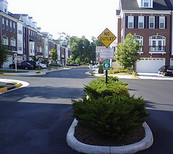For Old Town infill, more is better

The new proposal for Ratcliffe Hall is a familiar pod-style subdivision.
On Tuesday, Fairfax City heard a request by the developer of Ratcliffe Hall to downscale an already approved development near Old Town from 154 to 114 homes. The developer, Jaguar Homes, is also seeking to add 57 surface parking spaces. While the City Council and Planning Commission haven’t formally approved the request, the amendments will likely go through once Jaguar works out a few tweaks. That will continue an unfortunate trend toward fewer rather than more homes being built within walking distance of downtown Fairfax. But this isn’t the usual story of anti-neighbors blocking denser urban development.
Ratcliffe Hall was approved in early 2005 when the economy was humming and the developer saw a strong market for “active adult communities.” The development site, a 10-acre forested area along Main Street, lies right between several neighborhoods and Old Town and the County Judicial Center. The site is bisected by a stream. Most neighbors who testified supported the project. Jaguar had already built the pedestrian-oriented Providence Square condominiums in Old Town Fairfax, near Main Street Marketplace. The plan for Ratcliffe Hall was to front Main Street with 36 townhomes and provide 118 condominium units inside a single building on the other side of the stream. Now Jaguar wants to replace the 118 condos with a more conventional townhouse subdivision layout, consisting of 26 townhomes and 52 condo units. They want to replace underground parking with cheaper surface parking.
If there’s a silver lining, it’s that the city has an opportunity to improve pedestrian and bicycle access. With a few tweaks, the new residences could be better connected to the trail network and Old Town, and the new trail could provide better pedestrian and bicycle access for surrounding neighborhoods. Several city council and planning commission members pressed Jaguar to work with surrounding landowners to ensure that the trails are connected and flow into nearby destinations such as the Post Office. More townhomes will also likely bring a more varied mix of residents, including families.
Still, the proposed changes in both density and design are disappointing. Forty fewer residential units are a lot for a city struggling to add a critical mass of people and patrons to its downtown mix. Two new downtown restaurants have already closed. The new design is very inward-looking, with buildings oriented toward the parking garages and an internal “plaza,” instead of encouraging residents toward a shared public space — which the stream valley trail could be, with some changes in design.
